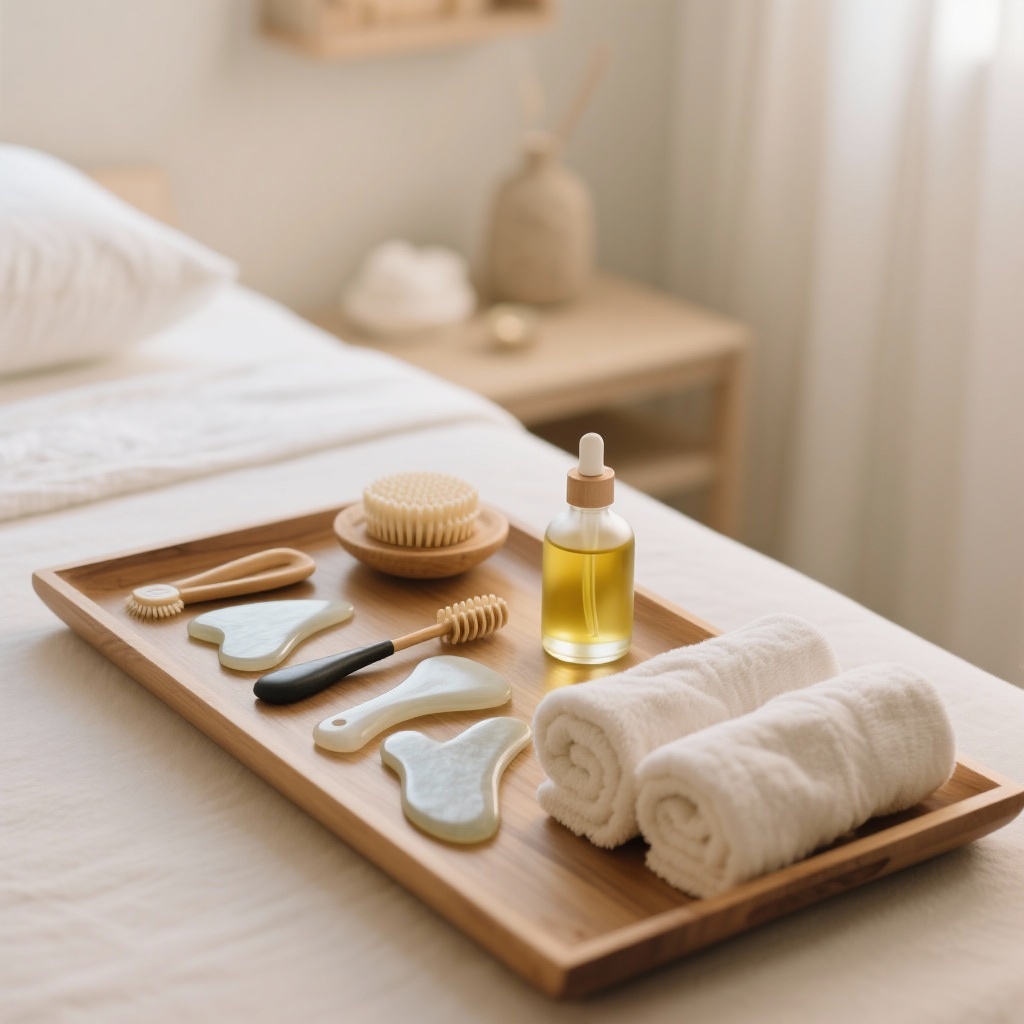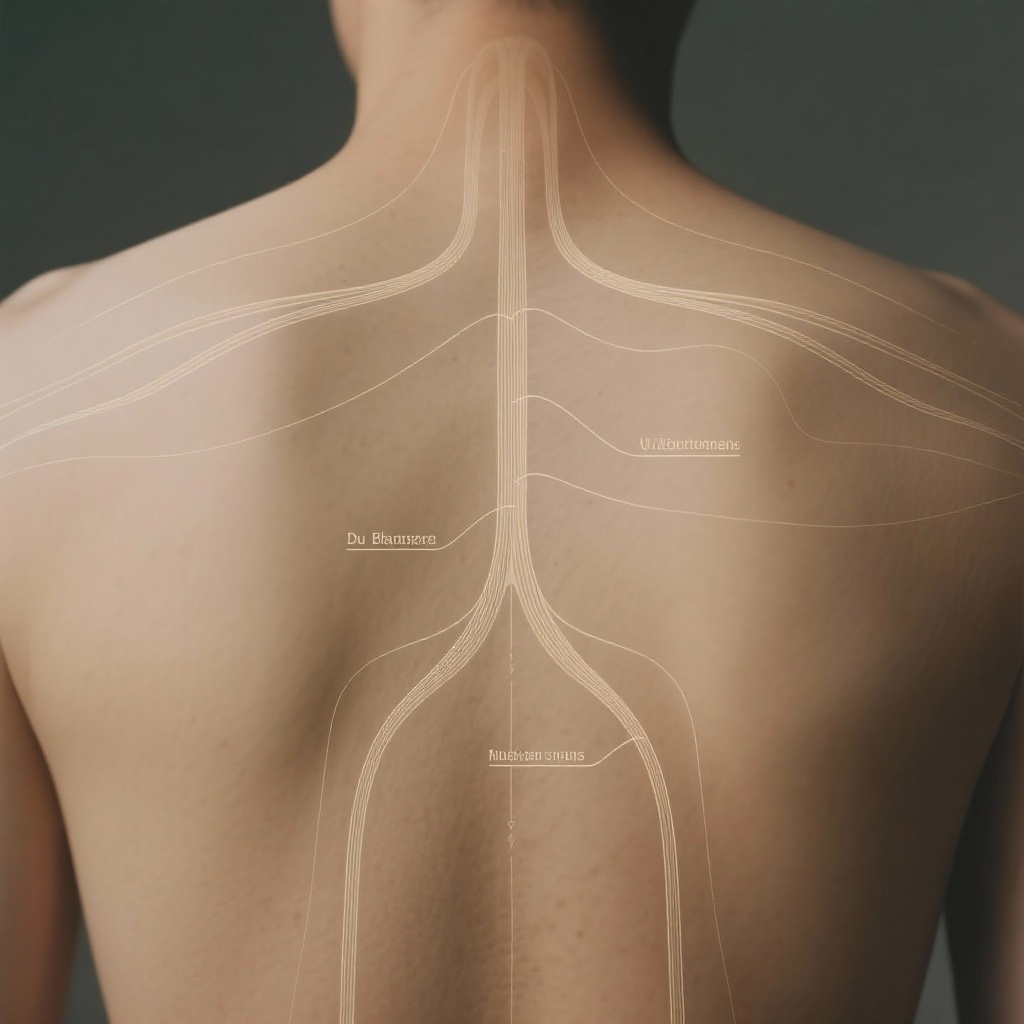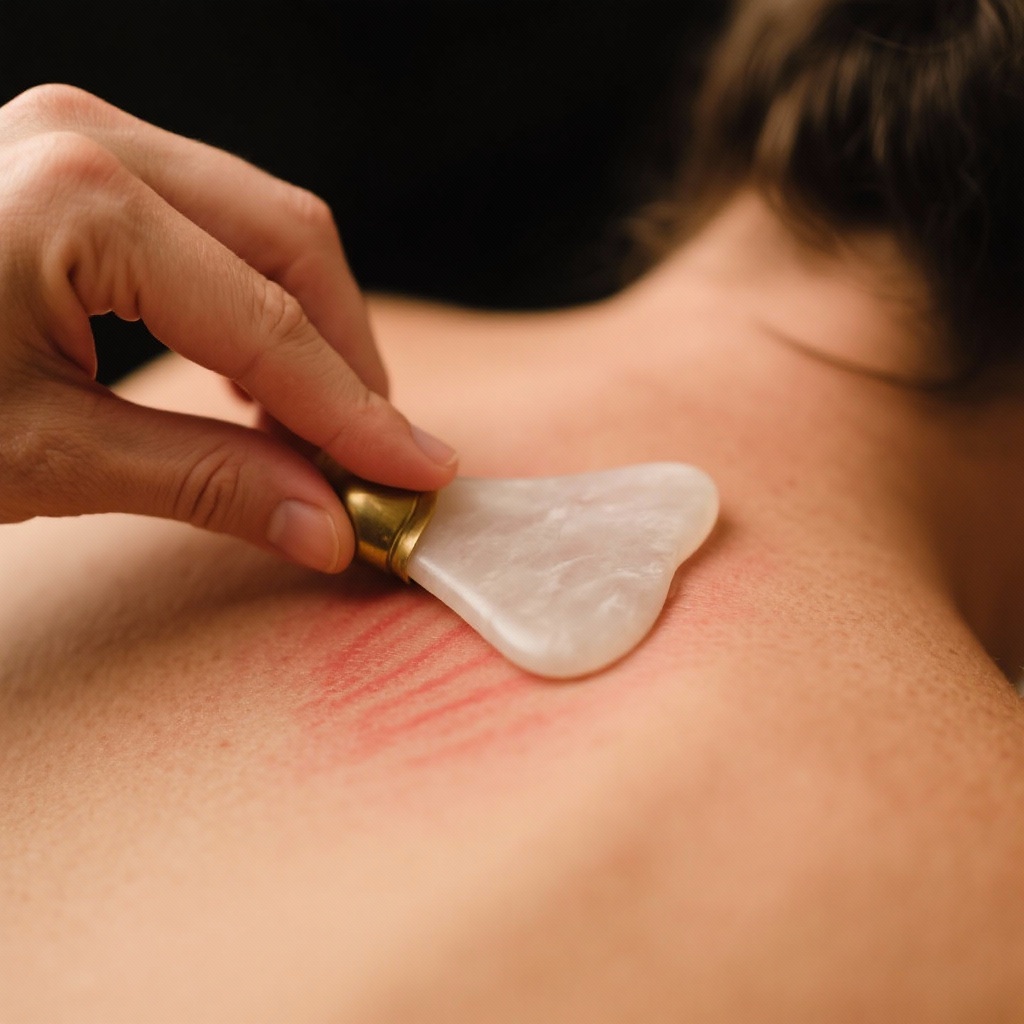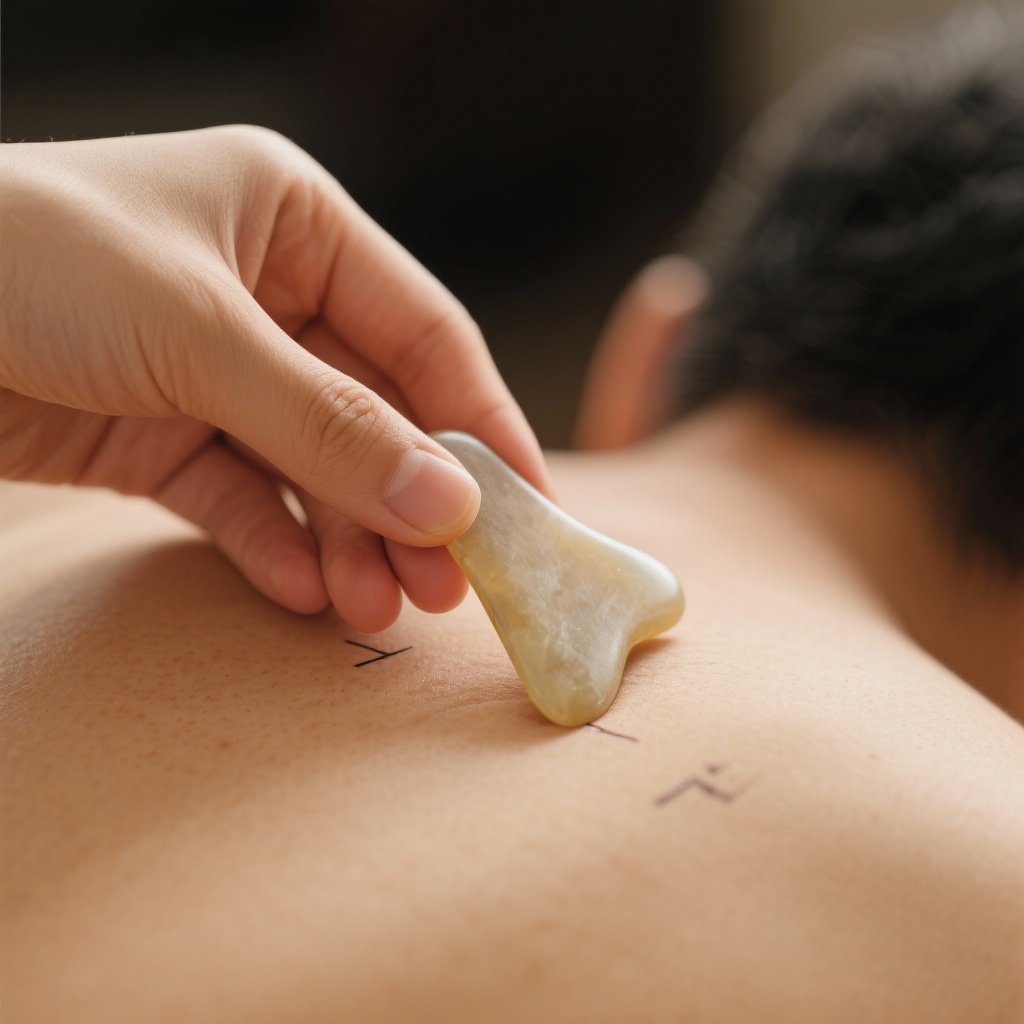Ready to unlock deep relaxation and better health? This guide breaks down the full Back Gua Sha process. Learn how to perform this ancient therapy safely at home. It can help alleviate tension and invigorate your body. Get ready to discover a simple yet profound wellness ritual.

Amazingly Simple Preparations: Setting the Stage for Successful Back Gua Sha
First, choose a warm, quiet spot for your session. The room temperature should feel comfortable, around 75-79°F. Grab a quality Gua Sha tool made from horn, stone, or stainless steel. You will also need some massage oil or essential oil for smooth gliding. Have the person lie face down, fully exposing their entire back. Ensure your hands are clean. Disinfect the Gua Sha tool with rubbing alcohol. Finally, apply a warm towel to the back for five to ten minutes. This step helps relax the muscles. It also boosts blood flow. It sets the perfect foundation for effective scraping.
Choose Your Space: Create a Relaxing Oasis
Gather Your Tools: Prepare for Smooth Gliding
Position for Comfort: Ensure Full Access
Clean and Sanitize: Maintain Good Hygiene
Warm Up Muscles: Enhance Circulation
Strategically Mapping Your Back: Uncovering Energy Pathways
Your back features two main energy pathways. These are the Du Channel and the Bladder Channel. The Du Channel runs straight down the spine’s midline. It extends from the Dazhui point to the Yaoshu point. The Bladder Channel has two distinct lines. The inner line sits about 1.5 inches from the spine. The outer line is roughly 3 inches from the spine. You will follow a specific order for scraping. Start with the Du Channel first. Then, move to the inner Bladder Channel line. Finish with the outer Bladder Channel line. Always work from top to bottom. For more on these channels, visit Acupoints & Meridians.
Identify Key Channels: Understand Your Pathways
Locate Du Channel: Target the Spine’s Center
Map Bladder Lines: Navigate Energy Routes
Follow the Sequence: Maximize Therapeutic Flow
Mastering the Strokes: Feel Your Body Release Tension
Begin by gently scraping the Du Channel. Start at the Fengfu point and move down to the Yaoshu point. Hold the Gua Sha tool at a 45-degree angle to the skin. Apply even pressure as you scrape. Perform five to eight strokes along each section. Mastering these specific strokes is key to effective Back Gua Sha. Next, scrape the first Bladder Channel line. This begins at the Fengmen point. It continues past key points like Feishu, Xinshu, Ganshu, Pishu, and Shenshu. It concludes at the Baihuan shu point. Afterward, address the second Bladder Channel line. This runs from Fufen to Zhibian. Continue scraping each area until the skin turns red. You might also see small red dots, called ‘sha’.

Scrape the Du Channel: Align Your Spine’s Flow
Address Bladder Line One: Open Vital Energy Gates
Move to Bladder Line Two: Deepen Your Release
Observe Skin Response: Know When to Stop
Targeting Key Pressure Points: Unlocking Deeper Benefits
Back-Shu points are vital access points. They directly influence your internal organs. These spots are where organ essence and energy gather. They require focused scraping. Focused attention on these vital points is essential for a complete Back Gua Sha experience. For instance, Feishu point aids respiratory issues. Xinshu point helps with heart circulation. Ganshu point eases tension, like a traffic jam in your body. Pishu point supports digestion. Shenshu point strengthens kidneys and the lower back. Use the Gua Sha tool’s corner here. Press gently or make small, targeted strokes. This technique intensifies the therapeutic effect. Learn more about vital life force at Qi & Blood.
Focus on Back-Shu Points: Connect to Organ Health
Support Respiratory Health: Target Feishu Point
Boost Heart Function: Stimulate Xinshu Point
Release Liver Tension: Activate Ganshu Point
Strengthen Digestion: Treat Pishu Point
Nourish Kidneys: Enhance Shenshu Point
Deepen Stimulation: Use Precision Techniques
Mindfully Applying Pressure: Optimizing Your Back Gua Sha Experience
The entire Back Gua Sha session should last twenty to thirty minutes. For beginners, use a light touch initially. Aim for a slight redness on the skin. Experienced users can increase pressure slightly. This aims for a few small ‘sha’ spots. Always observe the person’s reaction during scraping. If they feel uncomfortable, adjust the pressure immediately. You might need to pause completely. Never apply too much force. Excessive pressure could cause skin damage or bruising.

Set Your Time: Optimize Your Session Duration
Start Gentle: Begin with Light Pressure
Increase Gradually: Tailor to Experience Levels
Monitor Reactions: Prioritize Comfort and Safety
Avoid Over-Pressuring: Prevent Skin Damage
Thoughtfully Nurturing Post-Gua Sha: Enhancing Recovery
After your session, gently wipe the back with a warm towel. This removes any excess oil. Encourage the person to rest quietly for ten to fifteen minutes. They should avoid standing up immediately. For 24 hours, skip cold showers. Do not expose the back to direct drafts or air conditioning. Drink plenty of warm water. This helps flush toxins and aids metabolism. The appearance of ‘sha’ is completely normal. It typically fades naturally within three to seven days. During this time, do not scrape the same area again. For holistic wellness tips, visit Healthy Living.
Cleanse and Soothe: Gently Wipe the Skin
Rest and Recover: Allow Body to Settle
Avoid Cold Exposure: Protect Sensitive Areas
Hydrate and Detoxify: Support Internal Cleansing
Understand ‘Sha’ Appearance: Embrace Normal Healing
Give Skin a Break: Prevent Over-Stimulation
Smartly Scheduling Sessions: Prioritizing Your Wellbeing
Healthy individuals can benefit from Back Gua Sha, this powerful traditional Chinese Medicine therapy, an effective skin scraping technique, a natural pain relief method, and a holistic detoxification treatment. Aim for one to two sessions weekly. For those feeling run-down, two to three sessions might be helpful. However, some conditions prevent this beneficial myofascial release practice. Do not perform it during acute illness phases. Avoid it if you have skin diseases or bleeding disorders. This cupping alternative is also contraindicated for pregnant individuals. Patients with high blood pressure or heart conditions need caution. Use very gentle techniques for these cases. If someone experiences dizziness, nausea, or pale skin – known as ‘Gua Sha fainting’ – stop immediately. Have them lie down flat to rest.

Determine Your Frequency: Tailor to Your Health
Know When to Avoid: Recognize Contraindications
Exercise Caution: Adapt for Specific Conditions
Recognize ‘Gua Sha Fainting’: Respond to Adverse Reactions
References
- Gua Sha therapy for chronic low back pain: A randomized controlled trial. (PMID: 28838384)
- Gua Sha: a traditional technique for modern practice. (PMID: 23157297)
- Efficacy of Gua Sha on Pain and Functional Outcomes: A Systematic Review and Meta-Analysis of Randomized Controlled Trials. (PMID: 34823485)
Ready to feel better? Quick Self-Test & Rescue!
- If you often feel a stiff neck or persistent back tension, then immediately try gentle self-massage on your neck and shoulders for 30 seconds to release initial stiffness.
- If your energy levels consistently feel low, then immediately drink a glass of warm water with a slice of ginger and try 30 seconds of deep belly breathing to invigorate your body.
- If you frequently wake up feeling tired or unrested, then immediately take 30 seconds to stretch your arms overhead and twist gently side-to-side, promoting better circulation before starting your day.
Medical Disclaimer:This article is for educational use only and is not a substitute for professional medical advice.